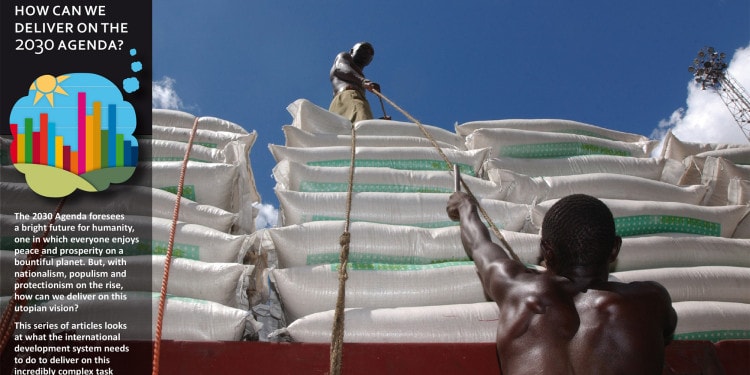This article is the Second of a series: Pipe dream or achievable vision: How can we deliver on the 2030 Agenda?
The 2030 Agenda foresees a bright future for humanity, one in which everyone enjoys peace and prosperity on a bountiful planet. But, with nationalism, populism and protectionism on the rise, how can we deliver on this utopian vision? This series of articles from the Food and Agriculture Organization of the United Nations (FAO) looks at what the international development system needs to do to deliver on this incredibly complex task – from rebuilding trust in multilateralism to bringing in the trillions of dollars needed each year to finance change.
The first article can be found here: “Trust or bust: The UN must put its house in order to attract finance for development”
Middle-income countries (MICs) account for one third of global Gross Domestic Product, serve as home to five billion people, and play a crucial role in global economic growth and stability. Yet most of these nations find themselves caught in a “middle-income trap”, unable to fulfil their potential.
The 2030 Agenda for Sustainable Development provides an unparalleled opportunity for MICs to overcome the lingering obstacles to moving up to high-income. To do so, they should align their policies with the goals of the agenda and take advantage of new structures that fund UN work in their own countries, helping to provide the trillions of dollars of investment needed for sustainability to become reality.
They can’t do it alone, however. The international community can strategically resource these countries to harness their massive potential – cementing MICs as key players, donors as well as recipients, in the changing global development landscape and allowing them to help bring least-developed countries (LDCs) up in their wake.

IN THE PHOTO: 26 June 2015, Volcan of Buenos Aires of Puntarenas (184 km southeast of the capital), Costa Rica – Operatives selected in chilli processing plant export agreement by the application of a systems approach to export to the United States sweet chilli (Chillies). Credit: FAO/Ezequiel Becerra
The middle-income trap
Countries at a certain level of development often get stuck in the middle-income trap when they struggle to further increase productivity based on the upgrading of human skills, technological development, innovation and other reforms, leading to a sharp deceleration in growth.
The World Bank estimates that of 101 countries and territories classed as middle-income in 1960, only 13 had become high income by 2008: Equatorial Guinea, Greece, Hong Kong SAR (China), Ireland, Israel, Japan, Mauritius, Portugal, Puerto Rico, Republic of Korea, Singapore, Spain, and Taiwan (Province of China). The subsequent financial crisis – and other negative trends – held back other nations from joining these ranks, causing widespread stagnation or decline in labour productivity growth among some MICs.
While countries in East and South Asia, despite the slowdown in China, showed a strong growth dynamic, European MICs were hit by the oil price collapse and intensified geopolitical tensions, leading to economic recessions in the Russian Federation and Ukraine in particular, with negative regional spill-over.
Growth in the MICs of Latin America and the Caribbean slowed between 2015 and 2017, with recessions in Argentina and Brazil. African MICs have also seen a downward trend: Nigeria and South Africa have suffered recent recessions, due to factors such as weak commodity prices, domestic political instabilities, weather-related shocks, and regional conflicts.
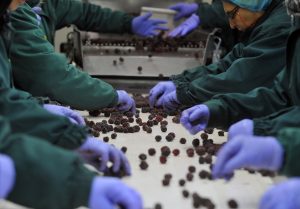
IN THE PHOTO: 11 November 2015, Zavlaka, Serbia – Employees sorting fresh blackberries as they move along the production line at Frikos factory. FAO project: OSRO/SRB/401/EC – Agricultural and Food Security Emergency assistance to flood-affected small-scale farmers in Serbia 2014/2015. CREDIT: FAO/Oliver Bunic
Due to volatilities in financial markets, commodity prices and exchange rates, as well as increases in trade-restrictive measures, MICs’ international trade was sluggish during 2015-2016, although exports have started to revive since mid-2016.
Even facing such problems, MICs are increasingly becoming providers of resources, advice and technical solutions, and brokers of collective action. The challenge is how to boost this trend by implementing policies in line with the 2030 Agenda, which will drive a successful transition to high-income status.
Realigning policies
The north/south divide of the Millennium Development Goals (MDGs) drew flak due to their focus on social sectors like health and education, leading them to overlook the arguably more fundamental area of economic transformation.
This was what South Korean Economist Ha-Joon Chang referred to as “development without development”. According to Chang, advanced countries that promoted liberalisation, thus “not allowing MICs to protect and promote their infant industries”, contributed to the middle-income trap, the “kicking down the development ladder” effect.
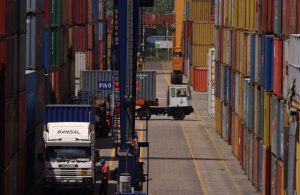
IN THE PHOTO: Trade in Dar Es Salaam, Tanzania: Dar Es Salaam Harbour, a major port in East Africa, loading and unloading shipping containers. This side of the port was sold to a private company from Hong Kong while the other side is still government-owned. CREDIT: FAO/Giuseppe Bizzarri
The 2030 Agenda, however, has put issues of inclusive growth, structural transformation, employment, and inequality as key themes. This is where the opportunity for MICs to escape the middle-income trap lies.
UN estimates show that with current global growth, lack of productivity growth and persistently high-income inequality, around 6.5 percent of the world’s population would still live in extreme poverty by 2030, with a significant number of them residing in MICs.
This is an obvious threat to SDG 1 on eradicating poverty, and SDG 8 on decent work and economic growth, including specific targets on achieving higher levels of economic productivity and sustaining per-capita economic growth.
To deal with these threats, development must adapt to the changing global context, including the role of bilateral providers of development cooperation and multilateral organisations in MICs. The 2030 Agenda – which requires the commitment of all countries – represents a change of approach to development strategies.
MICs need to strengthen productivity growth in the broad context of implementing the 2030 Agenda. Progress on achieving SDGs covering food security, human health, quality education, gender equality and infrastructure, industrialisation and innovation would improve labour productivity.
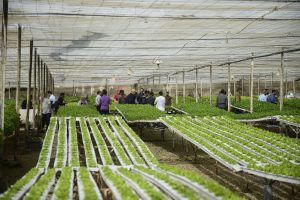
IN THE PHOTO: 14 November 2017, Cairo, Egypt – Fresh produce is seen growing inside greenhouses at Egyptian Hydrofarms co., the first hydrofarm company in Egypt, during the visit of an FAO team and farmers from Egypt, Algeria and Oman, part of the program of Farmer-to-farmer study trips. CREDIT: FAO/Khaled Desouki
MICs that align their policies towards implementation of the SDGs have an opportunity to converge with the most advanced economies. The 2030 Agenda and the SDGs would contribute to significant progress in policy areas at the heart of the middle-income trap: governance (rule of law and political stability); education (quality of secondary education and tertiary education attainment); investments in productive activities (including sustainable agriculture); capabilities; finance (liquidity in the stock market and domestic credit provided by the financial system); and taxation.
As the global development agenda has transitioned from the MDGs – which were not fully met by numerous MICs – to the 2030 Agenda, the provision of coherent, well-positioned, performance-based development assistance, aligned with specific country needs, both by the UN system and other actors, remains essential.
Donor, fund thyself
In this changing international development architecture, assistance to MICs to facilitate their progress towards the SDGs would benefit all parties in the global economy.
The UN remains engaged in development cooperation with MICs in multiple areas, in line with the 2030 Agenda, the Addis Ababa Action Agenda, the Paris Agreement on Climate Change, and national development programs – utilising a wide range of instruments, including technical assistance, policy advice and capacity development.
But many MICs, especially those in the upper strata, could also utilise their own resources to support the UN system to overcome the financial constraints impeding its catalytic activities at global and local level.
The projected reform of the UN development system has called for a revision of tools, business processes and frameworks to prepare the ground for a successful 2030 Agenda. Moving “from billions to trillions” in financing to back the agenda will require the capacity to understand the emerging national SDG agendas and come up with cutting-edge knowledge and partnerships.
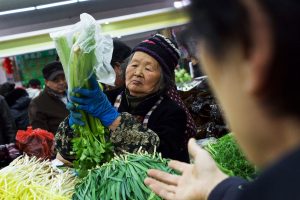
IN THE PHOTO: 05 March 2016, Beijing, China – Shoppers and vendors handling produce at a local market near Beijing’s Lucky Street. CREDIT: FAO/Justin Jin
With many countries graduating from low to middle-income status, aid agencies reorienting their beneficiaries in terms of Official Development Assistance (ODA), and the increasing bilateral nature of aid, domestic resource mobilisation will become more important. In this context, South-South and Triangular Cooperation (SSTC) and self-financing modalities where the donor and the recipient may be the same country but receive global knowledge assistance from multilateral institutions, including the UN, open up possibilities for MICs to spur their own development while also supporting the advancement of other countries, including Least Developed Countries (LDCs).
FAO has recognised the growing role of MICs in agriculture and food security: as global demand for agricultural products increases due to population growth in MICs – around 50 percent more food will be needed by 2050 to feed the world – swift and sustainable responses will be required to improve agricultural adaptation to and mitigation of climate change.
FAO has also recognized the role of MICs in this new aid architecture and is promoting self-financing mechanisms as a tool. With over 20 years of SSTC facilitation, FAO has worked with close to 100 partners to support the sharing and exchange of knowledge, good practices, policies and technology between countries in the global South.
FAO’s partners play various roles – sending out their exports and hosting others, and providing financial and/or technical resources to facilitate SSTC exchange. FAO intends to engage more countries as SSTC providers and upscale programs with existing partners to meet growing demands.
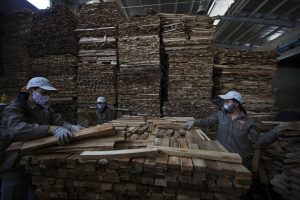
IN THE PHOTO: 18 May 2012, Back Kan, Viet Nam – Wood manufacturing. The Sahabak lumber yard, with more than one hundred workers, is a large-scale timber company producing high-quality wood for the manufacture of a variety of products. CREDIT: FAO/Joan Manuel Baliellas
A rising tide
MICs are undoubtedly becoming major actors and development partners; aid architecture and the development landscape should already be prepared to harness their role to support achievement of the SDGs. At the same time, MICs can use SDG policy alignment to boost their own economic and social status and go up the development ladder. Such processes should also create positive synergies with LDCs, through trade and investment channels and sharing of good practices, in particular within the context of South-South cooperation.
John F. Kennedy was fond of the phrase, “A rising tide lifts all boats”. In recent years, people have questioned whether the rising tide has only lifted the luxury yachts of the super-rich. However, if supported properly, MICs can be part of a swell that does indeed lift everybody.
The next article in the series, to be published on 20/02/2018 will look in more detail at Global food systems and Aid for Trade.
FEATURED PHOTO CREDIT: FAO/Giuseppe Bizzarri Editors note: The opinions expressed here by Impakter.com columnists are their own, not those of Impakter.com


